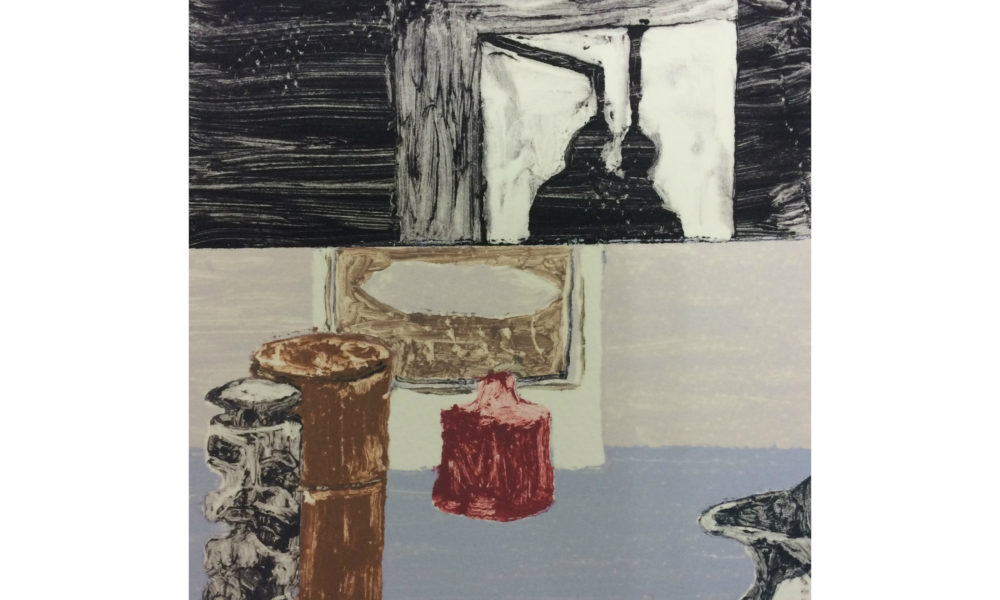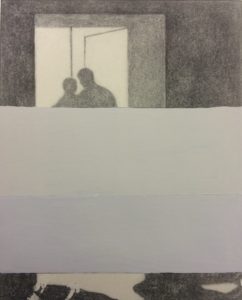
Object Relations: an exhibition of still life prints, drawings and paintings
Object Relations: an exhibition of still life prints, drawings and paintings by Juliet Scott
Helmsley Arts Centre, Yorkshire
Tuesday 4th October to Friday 28th October 2016
Title image: Still Life and Object Relations B3(4) merged Monotype, oil on Somerset paper, 56 x 37.5 cm
This exhibition in Helmsley Arts Centre, Yorkshire will be the first iteration of work emerging in my role as artist-in-residence of the Tavistock Institute’s archive project.

Still Life, 2016, Silverpoint on acrylic ground, 10 x 29.5cm
I will be showing ongoing work that links my previous study of still life with the social science practice and theory that was pioneered and developed over the last 70 years or so at the Tavistock Institute. The title of the show moves from the practice of assembling, arranging objects in different compositions and relations to the psychoanalytical theory of object relations. Object relations at the Tavistock Institute was a theory of Melanie Klein, the female Freud, who was one of a number of psychoanalysts and psychologists (Bowlby, Winnicott to name a few) studying our very early development and its impact on our behaviour as adults.
The pioneering work done by the Tavistock Institute was to connect this to group behaviour, organisations and more widely culture offering a language to the shape of society: its rifts, boundaries, defences, inclusions and exclusions. The richness of this approach was heightened by inter disciplinary collaboration amongst social scientists who recognised that the psyche could not be disconnected from the wider system. Systems theory itself was also emerging as a way to understand organisations as dedicated units of society and with a particular task or function to perform.
My new work is a developing series of drawings and prints that is a direct response to a set of object relations cards that caught my attention a year or two ago when we were first sifting through the archival material. The cards were used as projective tests by clinicians at the Tavistock Clinic and they follow a theory that human beings are driven by relationships with objects and that these objects are the development of internalised pictures of key experiences and evolve from the original (libidinal) feeding relationship with the mother and her two breasts, either good or bad depending on how they are received. A set of internalised objects become the source of the (re)search or drive and it is ‘these’ that the clinician is trying to surface when they present the cards to their patients.

What will be Still Life over Object Relations card B3(4),
Silverpoint on acrylic ground, 29.2 x 22.5 cm
I pinned these archival pieces to my studio wall where they remained for some time. When a response came it was to partially obscure them, make them into a surface for a new drawing and turn them into a new projective receptacle themselves. On the new surface I drew with silver and gold wire, a technique called metal point where a deposit is left on the paper as a result of the friction between the drawing and the ground. I then take the new composition, which is a merger of the wispy old image and my overdrawn still life and work on it as a painted print or monotype.
It is in this description of these works as the making of something new that the role of artist-in-residence meets the aims of the archive project as an instrument to enable the reimagining of social science theory and practice in the present day. Who knows how our object relations shift over time as each new generation is brought up in a different way, coddled and soothed by the child rearing books of our time. Each generation it seems searches for its own unique form and expression. As I lead and curate the project as a whole my question is whether those working in the Institute today can find a contemporary reimagining of applied research and consultancy from the rich and reflective record of the Institute’s work currently being catalogued into the Wellcome library.
The question of art, objects, artefacts or cultural interventions then returns as aesthetic forms that form part of a continued dialogue, discourse, conversation or working through on who and where we are. My conversation continues as the Institute’s archivist, Elena Carter gets deeper and deeper and uncovers further fragments that I might be able to work with, currently a box of duplicate papers from the War Officer Selection project awaits a rummage.
Helmsley Arts Centre
The Old Meeting House,
Helmsley,
York
YO62 5DW
Box Office: 01439 771700
http://www.helmsleyarts.co.uk/
Related
About Juliet Scott
I am the TIHR Archive Curator and artist-in-residence. I lead this truly exciting and groundbreaking project with its ethos of collaborative archival practice and its possibilities for bringing the unique and innovative social science approach of The Tavistock Institute to a renewed and wider audience. I am a current TIHR practitioner and teach organisational consultancy and change in the UK and further afield. Last year this took me to Argentina where I also travelled discovering the unique volcanic landscape of Payunia. More than anything I like to walk with friends and family, I have an allotment in Walworth, South East London where I am famous for my year round BBQs. It is very special place.Latest Posts By Juliet Scott
- 07.12.21#15 Social Dreaming Matrix: Covid-19 a year on. Notes from the final matrix and review 24th June 2021
- 07.12.21#14 Social Dreaming Matrix: Covid-19 – a year on. Notes from 17th June 2021
- 06.08.21# 12 Social Dreaming Matrix: Covid-19 a year on. Notes from 3rd June 2021
- 06.03.21# 11 Social Dreaming Matrix: Covid-19 a year on. Notes from 27 May 2021
- 05.28.21#10 Social Dreaming Matrix: Covid-19 a year on. Notes from 20th May